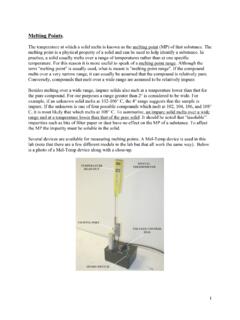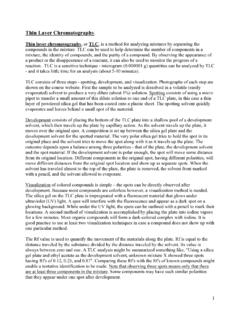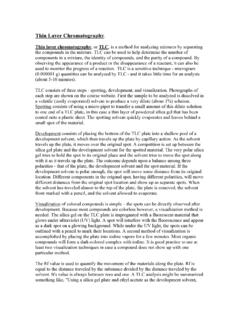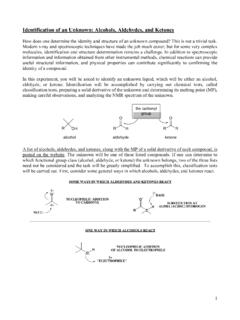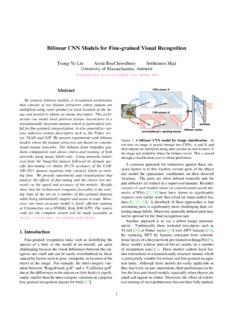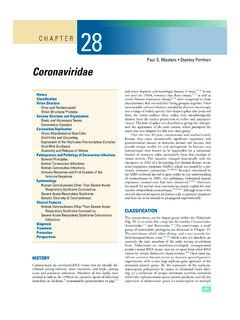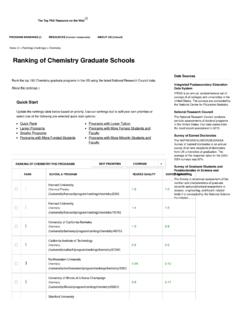Transcription of Recrystallization - University of Massachusetts Amherst
1 Recrystallization . Recrystallization is the primary method for purifying solid organic compounds. Compounds obtained from natural sources or from reaction mixtures almost always contain impurities. The impurities may include some combination of insoluble, soluble, and colored impurities. To obtain a pure compound these impurities must be removed. Each is removed in a separate step in the Recrystallization procedure. To understand the Recrystallization process, solubility behavior must first be considered. It is often stated that "like dissolves like". More correctly, it should be stated that "compounds having similar structural features will be soluble in one another".
2 Some obvious structural features that may affect solubility include polarity and the ability to hydrogen bond. For example, a compound having just a few carbons and an alcohol functional group (FG) would be expected to be soluble in solvents that have a few carbons and an alcohol FG or in some other polar solvent, and to be less soluble in nonpolar solvents. Conversely an alkane would be expected to show the opposite solubility behavior. In most cases though it is not as simple as this. If for example a compound has lots of carbons and hydrogens (> 6 C's) and just one alcohol group, the solubility will be dominated more by the alkyl part of the molecule than by the alcohol part, and the compound will show a solubility behavior more like that of an alkane.
3 For known compounds it is useful to consider the structure of the compound when choosing a Recrystallization solvent. An educated guess can save some time. Usually however, the structure of a compound may not be known so the solvent must be chosen by carrying out solubility tests. The first part of this experiment involves carrying out solubility tests on known compounds. Later on such solubility tests will be used to find a suitable Recrystallization solvent for an unknown compound. A compound usually exhibits one of three general solubility behaviors: (1), the compound has a high solubility in both hot and cold solvent, (2), the compound has a low solubility in both hot and cold solvent, and (3), the compound has a high solubility in hot solvent and a low solubility in cold solvent.
4 Solvents which exhibit the first two behaviors are not useful for recrystallizing a compound. A solvent showing the third behavior, that is, high solubility at high temperatures and low solubility at low temperatures, is one that is suitable for use as a Recrystallization solvent. Good Bad solubility --->. Bad temperature --->. Consider the three different types of impurities that may be present in a sample: soluble, insoluble, and colored. In theory, insoluble impurities can be removed from a compound fairly easily. The compound is dissolved in a solvent, the solution is filtered to remove the insoluble impurities, and the solvent evaporated to produce the solid compound.
5 The insoluble impurities are left behind in the filter paper. Colored impurities can be removed in a similar way but with an additional step. The solid is dissolved in a solvent, activated charcoal is added, the solution is filtered as before, and the solvent is evaporated to produce the solid compound. The charcoal, which has adsorbed the colored impurities, is left behind in the filter paper. The third type of impurity, the soluble impurity, cannot be filtered out because it has solubility characteristics similar to those of the desired compound (hence the name soluble impurity).
6 To remove soluble impurities, first, by doing solubility tests, a suitable solvent is chosen (high solubility in hot solvent, low solubility in cold solvent). The soluble impurities are then removed as follows: the desired compound along with the soluble impurities are dissolved in a MINIMUM of near-BOILING solvent. The solution is then allowed to cool slowly and without interruption. As the solution cools, the solubility of the compound (and of the soluble impurities) decreases, the solution becomes saturated with the desired compound, and the compound begins to crystallize.
7 Because formation of crystals is a highly selective process that usually excludes foreign molecules, only crystals of the desired compound form. Because the soluble impurities are present in smaller amounts, the solution never becomes saturated with the impurities, so the impurities remain in solution even after the solution has cooled. Removing the solution from the crystals thus removes the solvent and the soluble impurities from the desired crystals. A final rinse with a MINIMUM of ICE-COLD solvent followed by its removal cleans off any residual soluble impurities clinging to the surface of the desired crystals.
8 After allowing the solvent to evaporate, pure crystals of desired compound should remain. The weight and usually the MP of the crystals would be determined, and along with the % recovery, would be included in the report. In practice, by following a set procedure, the same solvent is used throughout the whole Recrystallization process, and the impurities are removed one by one. Note that in any Recrystallization some of the desired product is sacrificed and the recovery will be less than 100%. This is because even at the lower temperatures the desired compound has some finite solubility in the Recrystallization solvent and is thus lost when solvent and soluble impurities are removed.
9 To illustrate this look at the solubility of acetanilide in water. H. N. Solubility in 100 mL water O. g at 10 C; 5 g at 99 C. Acetanilide If 5 g were dissolved in 100 mL of water at 99 and then allowed to cool to 10 , g would crystallize out and g would remain in solution. The recovery then would be 90%. The 10%. remaining in solution would be lost. Recrystallization summary. For most of the recrystallizations done here you may assume that only soluble impurities are present. The six steps used here to recrystallize a compound are, (1) carry out solubility tests to determine a suitable solvent; (2) dissolve the solute in a minimum of near- boiling solvent; (3) allow the solution to cool slowly and undisturbed to room temperature (RT).
10 Then possibly to ice temperature; (4) collect the crystals by filtration; (5) rinse the crystals with a minimum amount of ice-cold solvent; and (6) allow the crystals to dry. What can go wrong in a Recrystallization ? Care must be taken at each step to obtain good results, which can be measured by % recovery and purity of the desired compound. Fortunately for most of the recrystallizations done in this course, for various reasons, colored impurities and insoluble impurities will not be present. Removing soluble impurities will thus be the focus of most recrystallizations done here.
